+ Open data
Open data
- Basic information
Basic information
| Entry | Database: PDB / ID: 1s4k | ||||||
|---|---|---|---|---|---|---|---|
| Title | Putative cytoplasmic protein from Salmonella typhimurium | ||||||
 Components Components | putative cytoplasmic protein ydil | ||||||
 Keywords Keywords | structural genomics / unknown function / MCSG / Salmonella typhimurium / PSI / Protein Structure Initiative / Midwest Center for Structural Genomics | ||||||
| Function / homology |  Function and homology information Function and homology information | ||||||
| Biological species |  Salmonella typhimurium (bacteria) Salmonella typhimurium (bacteria) | ||||||
| Method |  X-RAY DIFFRACTION / X-RAY DIFFRACTION /  SYNCHROTRON / SYNCHROTRON /  SAD / Resolution: 1.9 Å SAD / Resolution: 1.9 Å | ||||||
 Authors Authors | Cuff, M.E. / Li, H. / Collart, F. / Joachimiak, A. / Midwest Center for Structural Genomics (MCSG) | ||||||
 Citation Citation |  Journal: To be Published Journal: To be PublishedTitle: Putative cytoplasmic protein from Salmonella typhimurium Authors: Cuff, M.E. / Li, H. / Collart, F. / Joachimiak, A. | ||||||
| History |
| ||||||
| Remark 300 | BIOMOLECULE THIS ENTRY CONTAINS THE CRYSTALLOGRAPHIC ASYMMETRIC UNIT WHICH CONSISTS OF 2 CHAIN(S). ...BIOMOLECULE THIS ENTRY CONTAINS THE CRYSTALLOGRAPHIC ASYMMETRIC UNIT WHICH CONSISTS OF 2 CHAIN(S). THE BIOLOGICAL UNIT IS UNKNOWN. |
- Structure visualization
Structure visualization
| Structure viewer | Molecule:  Molmil Molmil Jmol/JSmol Jmol/JSmol |
|---|
- Downloads & links
Downloads & links
- Download
Download
| PDBx/mmCIF format |  1s4k.cif.gz 1s4k.cif.gz | 70.3 KB | Display |  PDBx/mmCIF format PDBx/mmCIF format |
|---|---|---|---|---|
| PDB format |  pdb1s4k.ent.gz pdb1s4k.ent.gz | 52.6 KB | Display |  PDB format PDB format |
| PDBx/mmJSON format |  1s4k.json.gz 1s4k.json.gz | Tree view |  PDBx/mmJSON format PDBx/mmJSON format | |
| Others |  Other downloads Other downloads |
-Validation report
| Summary document |  1s4k_validation.pdf.gz 1s4k_validation.pdf.gz | 431.9 KB | Display |  wwPDB validaton report wwPDB validaton report |
|---|---|---|---|---|
| Full document |  1s4k_full_validation.pdf.gz 1s4k_full_validation.pdf.gz | 434.4 KB | Display | |
| Data in XML |  1s4k_validation.xml.gz 1s4k_validation.xml.gz | 18.1 KB | Display | |
| Data in CIF |  1s4k_validation.cif.gz 1s4k_validation.cif.gz | 25.6 KB | Display | |
| Arichive directory |  https://data.pdbj.org/pub/pdb/validation_reports/s4/1s4k https://data.pdbj.org/pub/pdb/validation_reports/s4/1s4k ftp://data.pdbj.org/pub/pdb/validation_reports/s4/1s4k ftp://data.pdbj.org/pub/pdb/validation_reports/s4/1s4k | HTTPS FTP |
-Related structure data
| Similar structure data | |
|---|---|
| Other databases |
- Links
Links
- Assembly
Assembly
| Deposited unit | 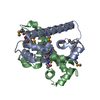
| |||||||||
|---|---|---|---|---|---|---|---|---|---|---|
| 1 |
| |||||||||
| Unit cell |
| |||||||||
| Components on special symmetry positions |
|
- Components
Components
| #1: Protein | Mass: 14398.629 Da / Num. of mol.: 2 Source method: isolated from a genetically manipulated source Source: (gene. exp.)  Salmonella typhimurium (bacteria) / Strain: LT2 / Gene: ydiL / Plasmid: pMAGIC / Species (production host): Escherichia coli / Production host: Salmonella typhimurium (bacteria) / Strain: LT2 / Gene: ydiL / Plasmid: pMAGIC / Species (production host): Escherichia coli / Production host:  #2: Water | ChemComp-HOH / | Has protein modification | Y | |
|---|
-Experimental details
-Experiment
| Experiment | Method:  X-RAY DIFFRACTION / Number of used crystals: 1 X-RAY DIFFRACTION / Number of used crystals: 1 |
|---|
- Sample preparation
Sample preparation
| Crystal | Density Matthews: 2.64 Å3/Da / Density % sol: 53.37 % |
|---|---|
| Crystal grow | Temperature: 294 K / Method: vapor diffusion, sitting drop / pH: 4.5 Details: NaH2PO4, K2HPO4, acetate, sucrose, pH 4.5, VAPOR DIFFUSION, SITTING DROP, temperature 294K |
-Data collection
| Diffraction | Mean temperature: 150 K |
|---|---|
| Diffraction source | Source:  SYNCHROTRON / Site: SYNCHROTRON / Site:  APS APS  / Beamline: 19-ID / Wavelength: 0.97885 Å / Beamline: 19-ID / Wavelength: 0.97885 Å |
| Detector | Type: CUSTOM-MADE / Detector: CCD / Date: Dec 21, 2003 / Details: SBC2 |
| Radiation | Monochromator: sagitally focussed Si(111) / Protocol: SINGLE WAVELENGTH / Monochromatic (M) / Laue (L): M / Scattering type: x-ray |
| Radiation wavelength | Wavelength: 0.97885 Å / Relative weight: 1 |
| Reflection | Resolution: 1.85→50 Å / Num. all: 22681 / Num. obs: 22681 / % possible obs: 86 % / Observed criterion σ(F): 0 / Observed criterion σ(I): 0 / Biso Wilson estimate: 23.8 Å2 / Limit h max: 40 / Limit h min: 0 / Limit k max: 47 / Limit k min: 0 / Limit l max: 41 / Limit l min: 0 / Observed criterion F max: 1820160.98 / Observed criterion F min: 7.6 |
| Reflection shell | Resolution: 1.85→1.92 Å / Mean I/σ(I) obs: 3.34 / Num. unique all: 1536 / Rsym value: 0.37 / % possible all: 59.2 |
- Processing
Processing
| Software |
| ||||||||||||||||||||||||||||||||||||||||||||||||||||||||||||||||||||||||||||||||||||||||||
|---|---|---|---|---|---|---|---|---|---|---|---|---|---|---|---|---|---|---|---|---|---|---|---|---|---|---|---|---|---|---|---|---|---|---|---|---|---|---|---|---|---|---|---|---|---|---|---|---|---|---|---|---|---|---|---|---|---|---|---|---|---|---|---|---|---|---|---|---|---|---|---|---|---|---|---|---|---|---|---|---|---|---|---|---|---|---|---|---|---|---|---|
| Refinement | Method to determine structure:  SAD / Resolution: 1.9→28.89 Å / Rfactor Rfree error: 0.006 / Occupancy max: 1 / Occupancy min: 0.5 / Isotropic thermal model: isotropic / Cross valid method: THROUGHOUT / σ(F): 0 / σ(I): 0 / Stereochemistry target values: Engh & Huber SAD / Resolution: 1.9→28.89 Å / Rfactor Rfree error: 0.006 / Occupancy max: 1 / Occupancy min: 0.5 / Isotropic thermal model: isotropic / Cross valid method: THROUGHOUT / σ(F): 0 / σ(I): 0 / Stereochemistry target values: Engh & Huber
| ||||||||||||||||||||||||||||||||||||||||||||||||||||||||||||||||||||||||||||||||||||||||||
| Solvent computation | Solvent model: CNS bulk solvent model used / Bsol: 57.2816 Å2 / ksol: 0.378132 e/Å3 | ||||||||||||||||||||||||||||||||||||||||||||||||||||||||||||||||||||||||||||||||||||||||||
| Displacement parameters | Biso max: 87.07 Å2 / Biso mean: 32.19 Å2 / Biso min: 16.06 Å2
| ||||||||||||||||||||||||||||||||||||||||||||||||||||||||||||||||||||||||||||||||||||||||||
| Refine analyze |
| ||||||||||||||||||||||||||||||||||||||||||||||||||||||||||||||||||||||||||||||||||||||||||
| Refinement step | Cycle: LAST / Resolution: 1.9→28.89 Å
| ||||||||||||||||||||||||||||||||||||||||||||||||||||||||||||||||||||||||||||||||||||||||||
| Refine LS restraints |
| ||||||||||||||||||||||||||||||||||||||||||||||||||||||||||||||||||||||||||||||||||||||||||
| LS refinement shell | Refine-ID: X-RAY DIFFRACTION / Total num. of bins used: 8
| ||||||||||||||||||||||||||||||||||||||||||||||||||||||||||||||||||||||||||||||||||||||||||
| Xplor file |
|
 Movie
Movie Controller
Controller



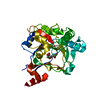
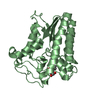

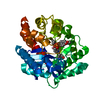
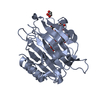
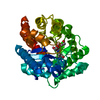
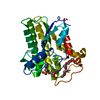

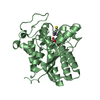
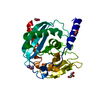
 PDBj
PDBj



